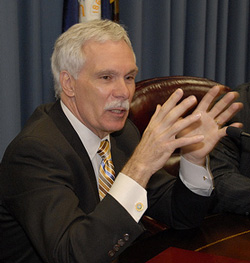 As the prices of better-known biodiesel feedstocks, such as soybeans, remain high, more refiners are looking for additional sources for the green fuel. The latest feedstock might be some of the weeds you’re battling in your garden this year.
As the prices of better-known biodiesel feedstocks, such as soybeans, remain high, more refiners are looking for additional sources for the green fuel. The latest feedstock might be some of the weeds you’re battling in your garden this year.
This story from the Albany (NY) Times Union says Innovation Fuels Inc., already producing 40 million gallons of biodiesel at its New York Harbor location from nonedible animal fats and used vegetable oils, is looking to what many people are NOT trying to grow as a source for two other plants at Fulton and Hampton, NY:
Innovation Fuels also is looking at other plant sources — mustard seeds, pennycress and camelina — that could produce the oils for biodiesel, said chief executive John Fox.
“They grow in northern regions, and grow in the shoulder months,” he said in a phone interview Thursday. The plants could be interplanted with corn and soybeans, and harvested with the same equipment. “You can do two plantings a year.”
In the past, the plants have been considered annoyances. “There’s a lot of research on how to eradicate them, but very little on how to cultivate them,” Fox said.
He said the weeds being explored as oil sources can yield 80 to 100 gallons of biodiesel per acre, compared to 40 gallons per acre for soybeans.
Recently, Innovation Fuels set up $15.5 million in financing, possibly for the new biodiesel plants.


 In a statement, leaders from the Canadian Renewable Fuels Association (CRFA), the European Bioethanol Fuel Association (eBio), and the
In a statement, leaders from the Canadian Renewable Fuels Association (CRFA), the European Bioethanol Fuel Association (eBio), and the  Students at the University of New Mexico are going to be able to get to class using the green fuel biodiesel.
Students at the University of New Mexico are going to be able to get to class using the green fuel biodiesel. “Biodiesel was an obvious choice” says Alexander A. Aller, Manager, Public Transit Operations. “Right now, all of our large shuttles are alternatively fueled with either biodiesel or compressed natural gas. Although we have a small fleet, we are pleased to contribute to efforts that reduce carbon dioxide emissions, dependence on foreign oil, and the pace of global warming.”
“Biodiesel was an obvious choice” says Alexander A. Aller, Manager, Public Transit Operations. “Right now, all of our large shuttles are alternatively fueled with either biodiesel or compressed natural gas. Although we have a small fleet, we are pleased to contribute to efforts that reduce carbon dioxide emissions, dependence on foreign oil, and the pace of global warming.” Atlanta-based
Atlanta-based  An American biofuels company is teaming up with a British company to build several biodiesel plants able to make the green fuel from a variety of sources, including non-food feedstocks.
An American biofuels company is teaming up with a British company to build several biodiesel plants able to make the green fuel from a variety of sources, including non-food feedstocks.
 At today’s Annual Meeting EPIC unveiled Edgar the E Man. He’s the official mascot of EPIC and available to members for appearances at events. I got Reece Nanfito, EPIC Director of Marketing to take my picture with Edgar.
At today’s Annual Meeting EPIC unveiled Edgar the E Man. He’s the official mascot of EPIC and available to members for appearances at events. I got Reece Nanfito, EPIC Director of Marketing to take my picture with Edgar. The Ethanol Promotion and Information Council Annual Meeting is underway with keynote speaker, Dr. Robert Zubrin, on stage.
The Ethanol Promotion and Information Council Annual Meeting is underway with keynote speaker, Dr. Robert Zubrin, on stage. World leaders are meeting this week in Rome, Italy to discuss the current world food crisis.
World leaders are meeting this week in Rome, Italy to discuss the current world food crisis. The president of Brazil, whose country’s sugar cane has long been used to produce ethanol that fuels cars and trucks, delivered an impassioned defense of biofuels.
The president of Brazil, whose country’s sugar cane has long been used to produce ethanol that fuels cars and trucks, delivered an impassioned defense of biofuels. While agreeing that sustainability and innovation are needed, U.S. Agriculture Secretary Ed Schafer insisted that biofuels contribute only 2 or 3 percent to a predicted 43 percent rise in prices this year.
While agreeing that sustainability and innovation are needed, U.S. Agriculture Secretary Ed Schafer insisted that biofuels contribute only 2 or 3 percent to a predicted 43 percent rise in prices this year. A new report says millions of workers in the U.S. will benefit from a green economy… and many workers already have the skills to make the jump to clean energy jobs.
A new report says millions of workers in the U.S. will benefit from a green economy… and many workers already have the skills to make the jump to clean energy jobs. The National Resources Defense Council, a coalition of environmental organizations, has released a report titled “Job Opportunities for the Green Economy.” The paper, put together by the University of Massachusetts Amherst, takes a look at the potential of green jobs in 12 key states.
The National Resources Defense Council, a coalition of environmental organizations, has released a report titled “Job Opportunities for the Green Economy.” The paper, put together by the University of Massachusetts Amherst, takes a look at the potential of green jobs in 12 key states.